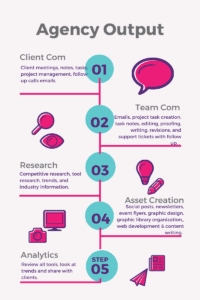When working with clients, we always look at their goals first. These goals can be process, financial, and systems driven. We want to help all of our small business customers reach their goals. Client happiness is vital to our success. We take pride in our services. We promise to work with you to create solutions that benefit the entire team.
Because integrity and accountability are two of our core values, we always strive to underpromise and overdeliver. I believe all of our small business customers are seeking the same level of excellence for their customers. However, lately, when doing business and providing social media engagement and review management, I have seen less patience and more customer expectations. My marketing colleagues agree. People are grumpier than ever. People seem to be demanding perfection from the companies they do buy from. I have also seen far less appreciation for the work that is done. I am unsure if it’s based on the political environment, climate change, inflation, or post covid fallout. But people are just not as nice as they used to be.
I began to wonder to myself. What are the statistics of human error? How often do people make mistakes? What is acceptable? What expectations are realistic? While we always strive for zero errors, errors will happen. Businesses use systems and tools to help prevent many mistakes. But human error still happens. Let’s look at some statistics I found.
 Human Error Statistics
Human Error Statistics
- 4% error rate for data entry with no verification steps. That means the error rate for data entered once, without further verification, is 400 per 10,000 entries – a significant number affecting even small datasets.
- $2.4B in property damage was caused by an erroneous human response to the partial meltdown of one of the plant’s nuclear reactors, resulting in the most significant accident in U.S. commercial nuclear power plant history.
- 251,454 deaths were caused by a human medical error in the U.S. alone in 2016, the third leading cause of death in the nation.
- Human-initiated errors cause 90% of all cyber-attacks. 52% of all data breaches stem from human error rather than technical vulnerabilities.
- 80% of airplane crashes are the result of human error, according to Boeing. Aviation Safety Magazine.
- 75% of data loss is caused by human error. 58% of service downtime is attributable to human mistakes. Human-initiated accidents cause 70% of all data center outages.
What Causes Human Error
Factors like lack of experience, attention loss, overwork, unreasonable deadlines, and fatigue can result in employees forgetting to complete tasks, sending documents to the wrong colleague or customer, or typing mistakes that impact terms in an email or contract. These errors might seem small, but such lapses have caused businesses to lose millions yearly. It might seem that we live in a digital era, and such mishaps in business processes are an exception. But, when you have to double-click the same area on a screen, use Ctrl + C and Ctrl + V or press the tick in a database for dozens or even thousands of times, it’s not surprising that by the 1001st time, you might choose a wrong option. Add other distractions, such as working in an office or from home with distractions, and the risk grows.
Is Human Error Normal
So just how normal is human error? Research suggests that humans make between 3-6 errors per hour regardless of the activity or task being conducted. One study in aviation maintenance performed by my former Australian Transport Safety Bureau (ATSB) colleague, Dr. Alan Hobbs, found that aviation maintenance engineers made, on average, 50 observable errors per work shift. The good news is that most of the time, these errors are self-corrected and have little consequence.
Human error knows no boundaries. Regardless of experience level, professionalism, gender, or national culture – everybody makes errors. However, the silver lining is that experts at particular tasks are often better than novices at anticipating mistakes and taking action to prevent them from becoming severe. The acceptable margin of error usually falls between 4% and 8% at the 95% confidence level in statistics.
Two Types Of Human Error
- Unintentional actions—when the right intention or plan is incorrectly carried out, or there is a failure to act. These actions typically occur due to attention, fatigue, or memory failures.
- Intentional actions—those actions that involve conscious choices. These actions are mainly due to poor judgment or motivational processes.
We would never cause an intentional error, but we sometimes have unintentional errors. Our five-person team produces a ton of assets every single day.
 On average, every day, we produce the following:
On average, every day, we produce the following:
- 1 client meeting with notes and actions
- 5-10 client calls or text clarification/follow-ups
- 2-4 vendor follow-up or support ticket issues
- 10-20 project management tasks
- 10-20 team interactions for editing and or assistance
- 50-100 emails to clients/staff/partners
- 20 social posts on over 6 social networks in 8 different tools
- 1 email newsletter in 3 different email systems
- 1 event flyer & 20 graphic images in design software
- 10 files created, saved, and organized in the graphic library
- 1 edit/update to a web page/1 blog post
- 1 research project on a tool or competitor
- 1 analytics report for all marketing tools and activities.
The even more interesting this is we move from tool to tool. We are in Google My Business, Mail Chimp, Facebook, WordPress, Google email, etc. Every tool has quirks, and Internet speed can be an issue. We can do everything right, but the tool could have a bug. We use proofing software like Grammarly and manually proof each other’s work. We deal with time zone differences and various client specifications. Every client has a different style or need. And around the holidays, our output can double. Despite pretty rigorous systems, we still make errors because our work changes daily. It’s not the same day in and day out where we can perfect it. But even then, people make mistakes.
Mistakes Do Happen
The simple reality is that every business needs to create standardized systems, processes, and methods, or you will always have high failure rates and poor performance. The typical failure rates in businesses using standard work practices range from 10-30 errors per one hundred opportunities. The best performance possible in well-managed workplaces using standard quality management methods is failure rates of 5-10 in every hundred options. You will get excessive failure rates even with highly experienced and able people doing the work. Letting people work from experience and knowledge always creates unwanted random variations that too often produce negative outcomes. What I found interesting in my research is even robots, and AI makes errors around 1% of the time.
Tools We Use To Help Reduce Errors
We use many different types of tools to help reduce errors. We use a project management tool to keep all of our notes from meetings and emails from clients so that the details are precise. We use Grammarly pro to help us with grammar and spelling. We edit and proof each other’s work. And we often require client sign-off as well. We have found that most mistakes happen when we rush through our systems to meet a client’s last-minute deadline or a change. In a perfect world, we would have plenty of time to complete all the marketing tasks during business hours. However, clients want things last minute, or a vendor/manufacturer is delayed, or any number of things can happen to derail the best-laid plans.
I sometimes think people expect perfection. Maybe that is my upbringing. I always want to produce an excellent end product. But mistakes happen, and we will always try to fix our mistakes. We create systems and processes to help alleviate errors when possible. But in a world of mistakes, try to focus on all the times people do the right thing. Be grateful for good service and good work. Go out of your way to compliment people. Positive affirmations are needed now more than ever. If all you are ever looking for is the bad or the mistakes, that is all you will ever see. Start seeking the good—the positive. Even better, be the good in the world. Not the complainer.
Sources:
- https://lifetime-reliability.
com/tutorials/human_error_ rate_table_insights/ - https://www.ocrolus.com/blog/human-error-8-eye-popping-sets-of-stats-and-examples/
- https://www.forbes.com/sites/forbestechcouncil/2021/02/22/why-you-should-consider-the-cost-of-human-error/?sh=25041384a328
- https://www.linkedin.com/pulse/human-factors-error-role-bad-luck-incident-graham-edkins/

